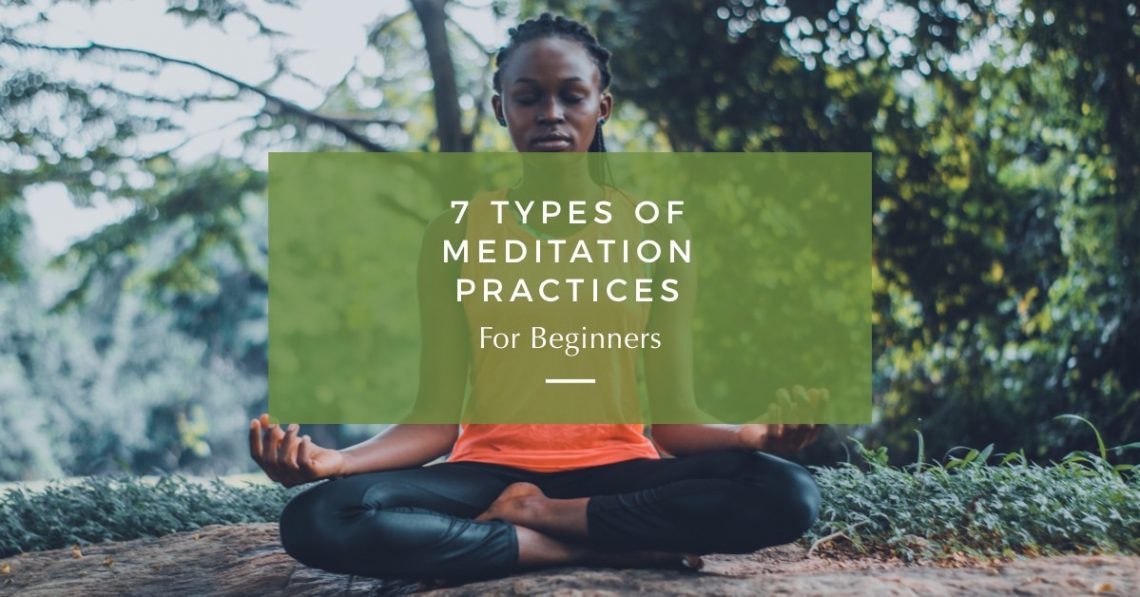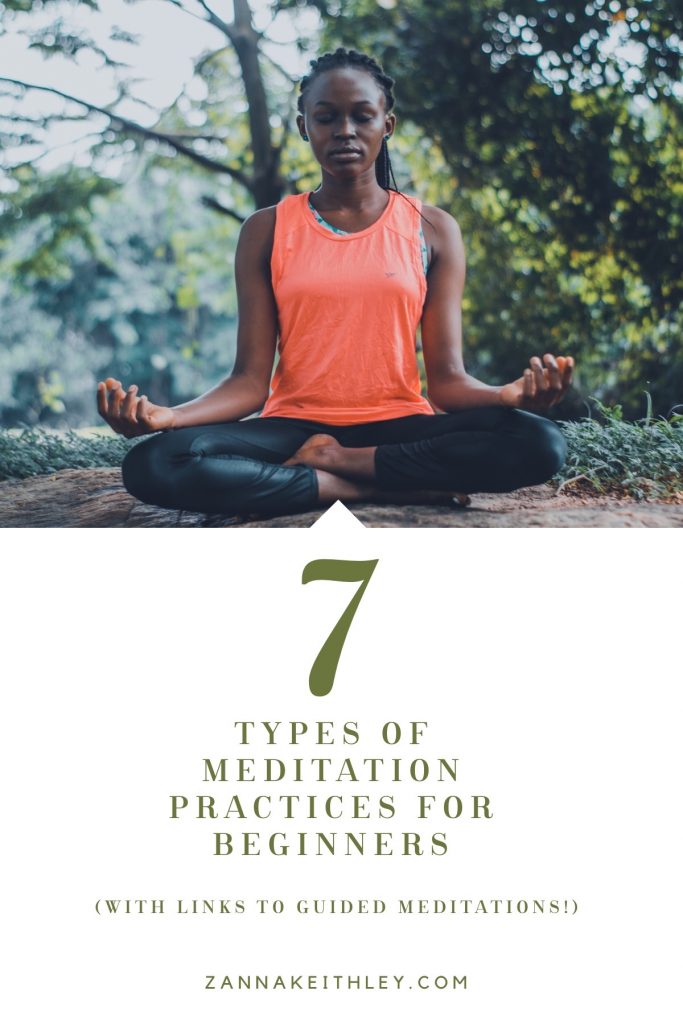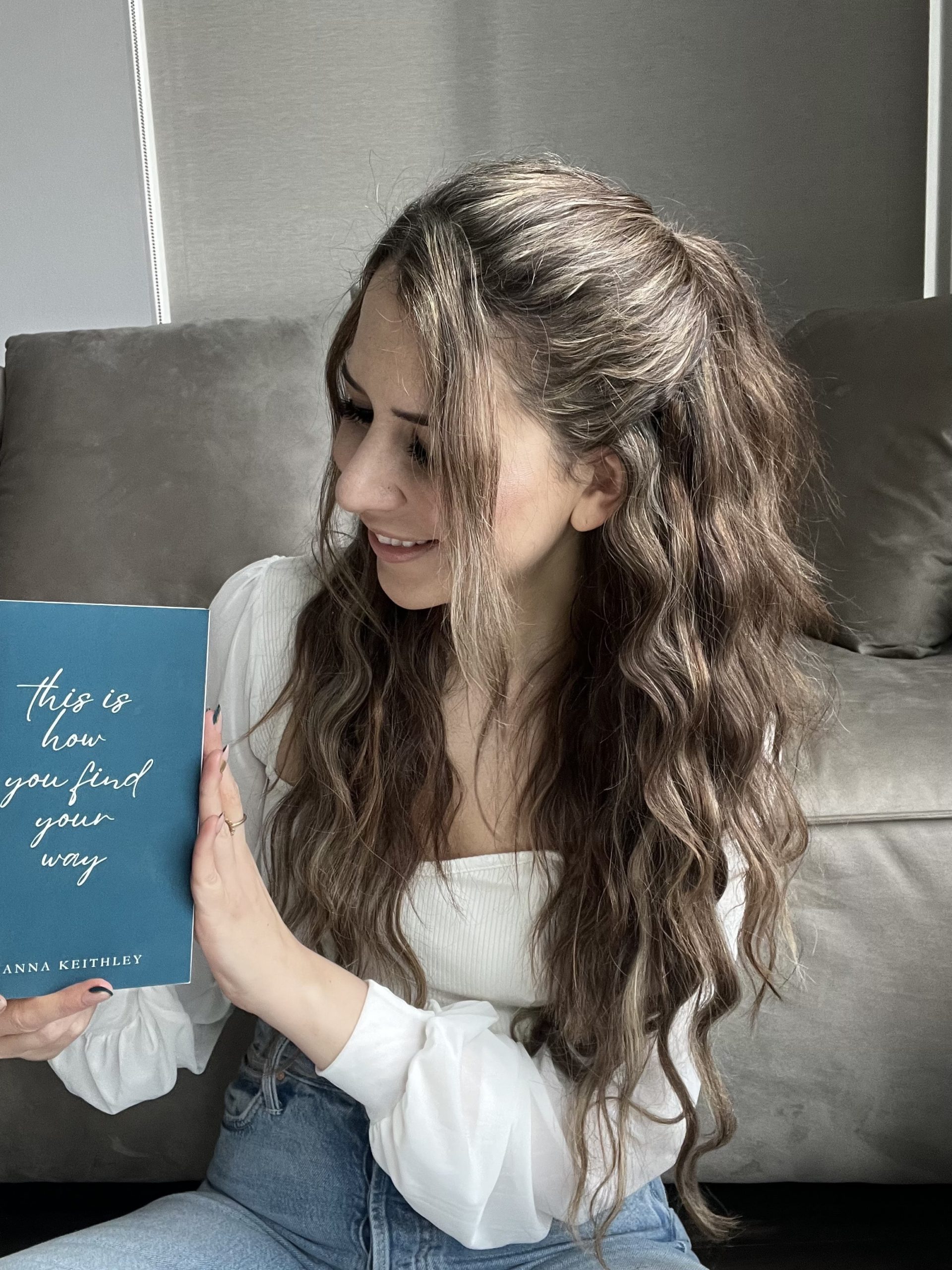
Meditation Practices For Beginners
Below, you’ll find seven types of meditation practices for beginners, including mindfulness, body scan, visualization, and chakra meditations. I also provide you with links to guided meditations you can try at your home today.

Meditation
If you’ve never meditated before, the thought of starting a meditation practice can feel kind of daunting. How do you start? When’s the best time to meditate? How are you supposed to sit, and what the heck do you do with your hands?
Here’s my answer to just about every question when it comes to starting a meditation practice: start where you are with what you have.
There will never be a perfect time to start meditating, and yet, it is always the perfect time to start meditating. You don’t need any special equipment. You don’t need to wait for a certain time of day. And you definitely don’t need to cultivate the special superpower of being able to clear your brain of thoughts. At most, you just need yourself and a few minutes of quiet.
Below, I’ve listed seven of the best types of meditation practices for beginners. While you can definitely choose any of these in any order, I’d recommend starting with mindfulness meditation, as that lays the foundation for just about every other type of meditation.
At the end of each section, I link to associated meditations on the Insight Timer app. I have absolute no affiliation with the Insight Timer app; it’s just my personal favorite for meditation. While I’ve linked to the meditations on Insight Timer’s webpage, I definitely recommend downloading the app on your phone for easier access.
Of course, if you find a different app that you want to use, go for it. You can even try multiple apps and see which one you like best. While you don’t need an app to meditate, it’s definitely helpful when first starting out.
Meditation FAQs
Before I get into the different types of meditation practices for beginners, here are some answers to a few more common questions that you may have.
What time of day should I meditate?
When I first started, I thought I needed to meditate as soon as I woke up because that’s what I had read in articles and blog posts. Meditating first thing in the morning is a great practice. But so is meditating an hour after you wake up. Or two hours later, or at lunch time, or before dinner, or after dinner, or before bedtime. Basically, anytime you want.
There is no right or wrong time to meditate. Do it when you have time and when it feels right for you.
How should I sit when I meditate? And what do I do with my hands?
In many of the guided meditations, the teacher will give you some instructions on how to sit, usually giving you a couple options depending on what’s most comfortable for you. If you’re on the floor, you can sit cross-legged with your hands on your knees and your palms facing up or down. If you’re on a chair, you can sit with your back straight, hands on knees, legs uncrossed.
And it may seem weird, but you can even lay down as well. It took me a while to try a meditation laying down, but it truly gave me a different and enriching experience.
Now, I’ll choose different positions depending on how I feel and what kind of meditation I’m doing.
What if I can’t clear my mind of thoughts?
This is one of the biggest misconceptions of meditation and why many people believe meditation isn’t for them. If you listen to just about any meditation teacher, they’ll tell you the same thing: meditation is not about clearing your mind of thoughts. If it was, I’m not sure any of us, not even the most advanced meditators, would ever succeed. The last thing we want to do is suppress or evade our own thoughts.
At its heart, meditation (especially practices rooted in mindfulness) is about non-judgmental observation, conscious awareness, and gently rooting ourselves in the present moment. When you’re meditating and your mind strays, don’t berate or speak down to yourself. You are not “wrong” for having a thought.
When I first started, I’d use the phrase, “Ah, I’m having a thought.” I imagined I was observing something curious and interesting but that I didn’t need to hold onto. Once I recognized the thought, I’d release it and come back to focusing on my breath.
Allow yourself to become an objective observer of your own mind and accept any thoughts you have. Then, gently guide your brain back to the present moment.
7 Meditation Practices For Beginners
Mindfulness Meditation
What exactly is mindfulness meditation? First, let’s look at the word mindfulness. Have you ever gotten so lost in thought that you’ve forgotten where you are or what you’re doing? Do you find yourself thinking about an event from the recent past and going over all the details? Do you replay old scenes over and over again, getting pulled into those past emotions? Or what about making up scenarios and obsessively playing out scenes of the future that haven’t even happened?
Can you imagine living a life where you’re always living in the past or future—never in the present moment?
This is where mindfulness comes in.
Mindfulness is conscious awareness of the present moment through an unattached, objective, and unemotional lens. Mindfulness allows you to notice when your thoughts have strayed and gently return them to this present moment. The key here is that you don’t judge yourself for your straying thoughts. You can simply notice that you’re having a thought and then release it without judgment.
A common analogy is to think of it as clouds passing over you in the sky. Imagine you’re lying on the ground looking up at a perfectly blue sky, and a cloud passes over you. “Look, there’s a cloud,” you think. Then it floats out of your vision, and you let it go without attachment.
That’s kind of how it works with your thoughts. In mindfulness meditation, you’re not trying to rid your head of thoughts; you simply notice with objective awareness when you’re having a thought, and then you let it pass over you and return to this present moment.
So how exactly do you stay grounded in this present moment?
Most often, it’s through your breath. In many mindfulness practices, you simply keep your focus on your breath coming in and going out of your body. And when you find your thoughts going astray, you return your focus to your breath.
In the beginning, it might help you to use numbers or a counting system. For example, for every inhale, you may think a silent one, and for every exhale, you think two.
Or you can count to ten: every inhale is an odd number and every exhale is an even number. When you get to ten, you return back to one and start all over again.
Insight Timer Guided Meditation Practices for Beginners:
Kate James’ Mindful Awareness Meditation (just under 10 minutes) gently guides you through the act of bringing mindful awareness to your present experience. This is a really wonderful meditation for guiding you through the process of becoming an objective observer of yourself.
Laurie J. Cameron’s Mindful Breathing With Compassion is a beautiful 10-minute practice that combines mindful breathing with a loving-kindness practice.
Body Scan Meditation
Body scan meditation is an extension of mindfulness in that it allows you to consciously notice how different parts of your body are feeling in the present moment without judgment.
In a body scan meditation, you start at your feet and make your way up, paying attention to the way each body part feels. (If you prefer, you can start at your head and move downward.)
Are you carrying tension in this particular body part? Are there any feelings or sensations? Don’t attach any value to your answers. For instance, if you’re feeling tension in your shoulders, don’t label this as bad. Just notice.
Now, there are differing beliefs on what a person should do next.
For some, the act of simply noticing is the goal of this meditation. The reason is that this grounds you in the present moment and cultivates a sense of mindfulness.
Others go one step further by consciously releasing the tension they perceive. One way to do this is by breathing into the tension. As you exhale, visualize the tension leaving your body and evaporating into the air. Another technique is to tense up your muscles and then relax them. You might also visualize a wave of relaxation flowing through your body.
While a body scan meditation can be done anytime, it’s especially beneficial in helping you to relax at nighttime. If you find yourself lying in bed at night unable to fall asleep, don’t try to suppress your thoughts. Instead, you can do a body scan meditation right there in your bed. Simply relax your muscles and release the tension from each part of your body.
Insight Timer Guided Meditation Practices for Beginners:
Wendy Chan’s Mindful Body Scan (just under 11 minutes) is a simple but powerful meditation that gently guides you through noticing the different sensations in your body without any judgment or labeling the sensations as good or bad.
Tara Brach is one of the most well-known meditation teachers both on and off the Insight Timer app. Her Basic Body Scan & Breath Awareness (11 minutes) is a perfect meditation for beginners.
Loving Kindness Meditation
The goal of a loving kindness meditation is to extend kindness toward yourself and others in your life. In the first loving kindness guided meditation I ever tried, I was instructed to visualize I was standing in front of myself. I looked myself in the eyes, and I repeated these words:
May you be well . . . may you be happy . . . may you live with ease . . . may you know you’re always loved.
Then, I was instructed to picture someone I loved and cherished deeply standing in front of me and to recite those same words.
Next, I visualized someone who I sort of, kind of knew but who I didn’t have any positive or negative feelings toward, such as a grocery store cashier or a neighbor down the street. Again, I envisioned looking them in the eyes and repeating those words. T
hen, I was guided to envision someone I felt negative feelings toward, to look this person in the eyes, and to recite these same kind and loving words as well.
And finally, I extended these words to the entire universe in which I am connected.
There are many variations of a loving kindness meditation, but at their core, they all promote deep feelings of love and compassion.
One great thing about this practice is that you don’t have to be sitting alone in a dark room to practice loving kindness. If you’re a beginner, it helps to do a few guided loving kindness meditations to understand the process and follow some of the different variations of this meditation. Soon, though, you may find different opportunities to engage with these practices.
For instance, when you’re getting ready in the morning and find yourself feeling stressed about the day ahead, you can look at yourself in the mirror and repeat words of loving kindness. If you have a boss who causes you to feel negative emotions, you can visualize looking them in the eyes and repeating these same words. This doesn’t mean that you agree with or accept the things you may not like about them. What it means is that you have the power to realign with your highest self and to choose love over resentment, anger, or pessimism.
Insight Timer Guided Meditation Practices for Beginners:
I love Vanessa Michele’s Loving Kindness For Yourself & Others (10 minutes) to cultivate a sense of love and compassion for yourself and the world around you.
Camilla Sacre-Dallerup’s Loving Kindness and Compassion (10 1/2 minutes) meditation is a beautiful variation of a traditional loving kindness meditation.
Visualization/Guided Imagery Meditation
In a visualization meditation, you focus on a specific visual in your mind’s eye. If you’re doing a guided meditation, your instructor will gently guide you through a series of visuals that you follow in your mind.
At its foundation, visualization meditations are still rooted in mindfulness. When you’re practicing a visualization meditation, you may find your mind wandering, thinking about the day ahead or noticing the very loud garbage truck outside your house. It’s okay if your mind wanders. Just notice, then allow yourself to return to the visualization.
So in a visualization meditation, what exactly are you visualizing? This is where, if you’re someone who likes concrete directions and specific answers, you may get frustrated. Because the truth is, there’s an infinite amount of scenes you may visualize in your mind’s eye.
For instance, I’ve done a lot of manifestation visualizations. Some of these guide me through visualizing a perfect day in my dream life, while others have taken me to golden waterfalls where abundance is infinite and always flowing. I’ve also done visualizations where I’ve floated down a gentle river and allowed myself to flow effortlessly with the water, trusting where the water takes me. I’ve visualized journeys into my own heart where I explore all of the dark and light inside of me. And I’ve also visualized standing in front of a beautiful ocean and releasing all of my hopes and dreams into the sea, entrusting the water with all of my heart’s desires.
A key for many visualization meditations is to not only see these scenes playing out in your mind but to experience them with all of your senses. If you find this to be difficult at first, it’s okay. This doesn’t mean you’re doing anything wrong or that you’re not “cut out” for this type of meditation.
I encourage you to open yourself to the process and simply let it be whatever it is. It doesn’t have to be a big or overwhelming thing; I’ve experienced many incredible guided visualization meditations that were only ten minutes long.
- Related: How to Visualize (For Meditation)
Insight Timer Guided Meditation Practices for Beginners:
Carrie Suwal’s Attracting All That You Desire (10 1/2 minutes) is a powerful meditation for manifestation that includes both visualization and affirmations.
My overall most-played meditation on the Insight Timer app is Rishika Anya’s Breaking Through Limiting ThoughtForms (just under 11 minutes). This is a powerful visualization meditation to help you break through limiting thoughts that no longer serve your ultimate wellbeing.
Affirmations Meditation
Affirmations meditations are generally pretty straightforward. These are guided meditations in which a teacher recites a series of affirmations, and you repeat these affirmations, either silently or aloud.
Often, a meditation dedicated to reciting affirmations will focus on a specific topic. Some of the guided affirmation meditations you may find include affirmations for abundance, self-love, worthiness, and health. You can also find morning affirmations specifically dedicated to cultivating a positive mindset for the day ahead. There are even affirmation meditations dedicated to specific topics such as job interview or giving a big speech.
Usually, the teacher will advise you on how to follow along with these affirmations. Sometimes, instead of repeating them, you simply breathe into each one and feel them into your being.
Note that you may encounter affirmations in other types of meditations as well. For instance, in a guided visualization meditation for manifestation, the teacher may include affirmations to affirm your worthiness of beautiful abundance in your life.
Insight Timer Guided Meditation Practices for Beginners:
Liza Colpa’s Manifestation & Affirmation Practice To Gain Confidence (12 minutes) is a perfect one for utilizing both visualization and affirmations to guide you in your personal growth. I absolutely love all of Liza’s meditations, so if you like this one, I’d definitely recommend checking out her others as well.
Karen Wang’s Words of Affirmation (10 minutes) beautifully guides you through a series of affirmations for self-confidence and empowerment.
Chakra Meditation
Chakras are your body’s spiritual energy centers. When our chakras are unblocked, energy flows freely within our body, mind, and spirit, and we feel a sense of alignment and peacefulness. When a chakra is blocked, we feel imbalanced, and this often manifests in negative physical, emotional, and spiritual symptoms (anxiety, creativity blocks, and digestive issues, for instance).
Chakra meditations usually focus on unblocking any blocked chakras so energy can flow freely. Some meditations will focus on increasing awareness and unblocking one specific chakra, while others do an overview of all the chakras. Below is a list of the chakras, their associated colors, and their locations within your body.
If this is your first introduction to chakras, I’d recommend starting with a meditation that guides you through all of the main chakras. Once you feel like you have a good foundational understanding of chakras, you can search for guided meditations that focus on unblocking a specific chakra.
Insight Timer Guided Meditation Practices for Beginners
Dexter and Alessandrina’s Personal Transformation: Energy Centers Chakra Discovery is a 12-minute guided meditation that leads you through each chakra in your body and its associated color. It’s a really great one for beginners!
Carrie Suwal, who I mentioned above in the Visualization Meditation section, has some beautiful chakra meditations that focus on trauma, depression, healing the heart, anxiety, and overall balancing. Note that most of these are a little longer than the others that I’ve listed, but if you’re drawn to gentle voices like I am, I think you’ll really love Carrie’s soft and tenderhearted guidance.
Mantra Meditation
In a mantra meditation, you focus on a word or a single syllable (or sometimes a phrase) for the entirely of the meditation. If you focus on a word, this word has no meaning. You wouldn’t say something like love, kind, peace, or any other word you have a connection to. Often, this word may not even be in the same language you speak. Some common examples of syllables or words you may repeat include om and ram.
(Okay, because I’m one that doesn’t like labeling anything in meditation as “right” or “wrong,” I concede that there are mantra meditations out there that will use a word that holds meaning to you, such as love or peace, and while you may receive a different type of experience, there is nothing inherently bad about this.)
During your meditation, you’ll repeat your chosen mantra (or the one your instructor has provided for you) over and over again. There is no rush here. Keep a smooth, relaxed, even tone. Focus on the sound of the mantra, and when your mind wanders, bring yourself back to the sound, just as you would in a standard mindfulness meditation practice.
As in all of the types of meditation listed here, you’ll likely find variations of this practice depending on the teacher. I’d recommend starting out with a guided meditation for this one, but after a couple times, this is one type of meditation that you may feel more comfortable trying without guidance.
Insight Timer Guided Meditation Practices for Beginners:
One of the first mantra meditations I ever tried was Dexter and Alessandrina’s Ganesha Mantra Meditation for Removing Obstacles (14 minutes). I’d recommend trying out some of the other meditation practices I’ve listed above before this one, but when you’re ready to try something different, this offers a really unique and powerful experience.
Hannah Leatherbury’s Mantra of Peace is nine-minute meditation that uses a phrase in the Sanskrit language that translates to “Lead me from the unreal to the real; Lead me from darkness (ignorance) to light (wisdom); Lead me from death (limitation) to life everlasting (freedom).” She also has a beautiful five-minute Mantra of Wholeness.


Zanna Keithley is an author, poet, and social media content creator who writes short prose dedicated to inspiring readers to follow their dreams, trust their intuition, and create beautiful and fulfilling lives. You can find her original writing on Instagram @zannakeithley.






One Comment
HolisticSoulHealings.com
I cannot stress how important meditation is, in my daily life. Because of this, creating a meditation space for myself was something I focused on when I got my new home. It has truly elevated my practice and I just hope more people will discover the benefits of meditation and apply this in their daily life. 🙂